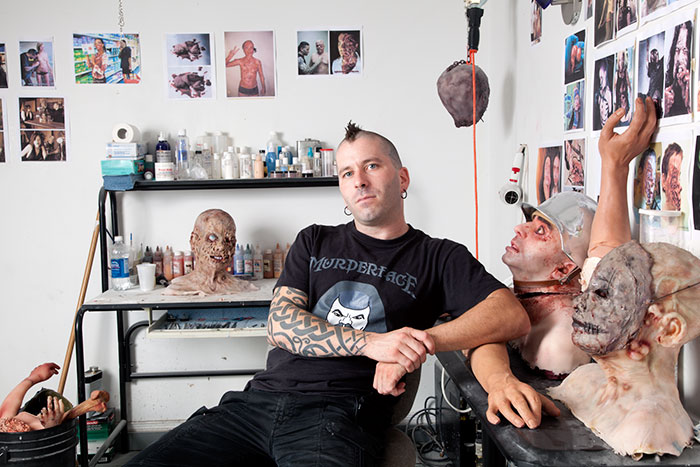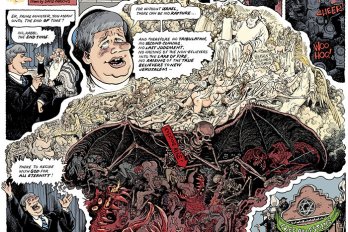By the end of the ’70s, horror fans had seen it all: teenage girls with spilled innards (Last House on the Left ), teenage boys dining on shit (Salò), buxom Nazis wielding electroshock vibrators (Ilsa: She Wolf of the SS). Ruggero Deodato’s Cannibal Holocaust shouldn’t have caused much of a stir, considering. But while the story served up conventional schlock—a documentary crew goes to the Amazon to film cannibals and winds up as dinner—the film was shocking because it seemed real. The action was presented as “found footage” rescued by a television network, and it was shot with hand-held cameras in the jungles of Colombia, where the slaughter of several animals lent credence to otherwise simulated gore. To further screw with the viewing public, Deodato barred his cast of unknowns from appearing publicly until a year after the movie’s Italian release, in February 1980. Five days later, the film was playing to sold-out audiences, and its director had been arrested for distributing snuff. Once his ploy was revealed, Cannibal Holocaust would earn millions more and inspire master’s theses for years to come.
In October 2009, acting on information from Interpol, Montreal cops tracked down the proprietor of a website called Inner Depravity—a collection of gruesome images presented as the visual diary of a serial killer. They had no idea they were on the trail of Deodato’s successor. The sicko turned out to be mild-mannered FX artist Rémy Couture. To build up his portfolio, he had donned a freakish mask and pretended to rape and mutilate women in stills and two short films (the second co-stars a grade school–age apprentice, who especially charmed the authorities). The police found no evidence of foul play but pressed charges anyway, and Couture is scheduled to stand trial for moral corruption from October 3 to 14. Meanwhile, he has become a poster boy for freedom of expression, and a known quantity among Canadian filmmakers and horror fans; a documentary about his case, Art/Crime, premiered at Montreal’s Fantasia film festival in July.
Nice words
English speakers test the limits of politeness
Jennifer Spinner
The content of books, films, and music may have grown nastier and more explicit through the ages, but the English language has done the reverse. From the late fourteenth century until the early 1700s, children born to unmarried mothers were commonly known as “whoresons.” Thereafter, “bastard” became the conventional term. Derived from the French fils de bast (“bast” being a basket made for horse travel), the term refers to “packsaddle children” conceived by the side of the road rather than in the marriage bed. Over time, some English speakers adopted a gentler term, “basket,” in reference to the pitiable child’s reliance on alms for survival. Nowadays, of course, we have no polite way of referring to the child of unwed parents. As for the ostensible fates of packsaddle children, the word “hoodlum,” possibly from a German term meaning “ragged evildoers,” gained popularity in the 1870s to describe violent youth gangs in San Francisco. Eventually, “juvenile delinquent” became a kinder alternative, followed by “at-risk youth” in the 1990s. Since then, some social service organizations have adjusted the nomenclature to “youth at promise.”
—Bronwen Jervis
Still, when I meet Couture at his Hochelaga apartment, after giving a friend the address to be on the safe side, the gorehound in me hopes for a genuine crazy. He extends a tattooed arm, then leads me down a narrow hallway to his basement studio, where I note the handsaw hanging ominously on a wall behind him. The FX work—prosthetic body parts and lurid glossies, tidily displayed along the room’s perimeter—offers a cheap thrill. But as Couture, who has warm blue-green eyes beneath a neatly trimmed mohawk, explains his vision, the willies elude me. “I like contrast,” he says, pointing to a picture of himself in a suit, lifting a kebab to his lips. “This one is really a fashion shot, but, you know, I’m eating fetuses.” I linger on a photograph of a nude woman in a burqa, masturbating to pictures of the Pope, which reminds me of the doodles a certain classmate used to show me. The feeling of déjà vu grows as I examine a demonic woman in bondage gear, and a legless man in chains. It turns out these images were inspired by Couture’s favourite films, Hellraiser and Saw.
Since Deodato’s time, horror has grown so nasty that “torture porn,” the visual study of worst-case scenarios, is now a mainstream genre; the Saw films, the genres’s best-known franchise, have grossed over $850 million worldwide. In court, Couture hopes to demonstrate that his grainy homages to necrophilia are relative child’s play, by screening the current shocker to beat: A Serbian Film depicts the rape of an eye socket and features something called “newborn porn.” (His lawyer says they are considering doing so.) Now that nothing is sacred, the ambitious creator must think beyond material, to stoke viewers’ imaginations rather than lance their eyeballs.
Couture garnered an audience for his website by blurring the distinction between fiction and reality—for the viewer, the line between thrill-seeking and outright sadism. “Think about the old carnival freak shows,” says Chris Alexander, editor-in-chief of Fangoria magazine and a walking encyclopedia of horror. “There was a tent and a guy outside telling you, ‘Do you dare come inside? Do you dare see the most horrible thing you’ll ever see in your life? ’ Your heart’s pounding, and you’re thinking, ‘Can I do it, can I do it? ’ Nine times out of ten, it’s some idiot in a rubber mask.”
No matter. If you’ve freaked ’em out, you’ve done your job. In horror, as in comedy, the goal is to elicit the right reaction by any means necessary; an uncomfortable laugh, à la Andy Kaufman, is as valid as a knowing one, à la Jerry Seinfeld. Note that nobody has ever called Deodato a brilliant director. But his film’s verisimilitude excused its dime-store plot and hammy acting, while the murder charge confirmed his proficiency in his medium—not cinema, but shock—and imbued his project with something it never had: an aesthetic dimension. As a horror artist, to be accused of crossing the line is akin to winning an Oscar.
Back in his brightly lit lair, Couture, who works at a tech job by day, speaks humbly of his FX work, but boasts uncharacteristically about how he disseminated it. “I never saw a website like mine,” he says. “It really is like a serial killer’s diary.” He worries about lawyer’s fees, but Alexander, who had never heard of Couture before his arrest, counters with a verbal pssh. “Studios have spent millions to create a steamrolling viral marketing campaign like this,” he says. “If you’re a struggling artist, your heart’s not going to bleed for Rémy. You’re going to look at him and go, ‘You son of a bitch. You did it!’”
This appeared in the October 2011 issue.






